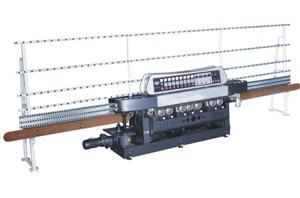Guangdong Fushan Glass Machinery Co., Ltd
Product List
- Glass Tempering Furnace
- Flat Glass Tempering Furnace
- Radiation Flat Tempering Furnace FT
- Forced Convection Flat Tempering Furnace CFT
- Combined Dual Chamber Flat Tempering Furnace SFT
- Double Row Fan Forced Convection Flat Tempering Furnace NCFT
- Bend Glass Tempering Furnace
- Double-curved Glass Bending Furnace FS-DBT
- Flat and Bent Glass Tempering Furnace
- Radiation Flat and Bent Tempering Furnace FBTC/FBTL
- Forced Convection Flat and Bent Tempering Furnace CFBTC
- Forced Convection Flat and Bent Tempering Furnace CFBTL
- Combined Glass Tempering Furnace
- Combined Dual Chamber Flat Tempering Furnace SFT
- Glass Edging Machines
- Glass Straight-Line Four Edger
- Glass Straight-line Double Edger
- 10 Spindle Glass Double Edger
- 20 Spindle Glass Double Edger
- 22 Spindle Glass Double Edger
- Glass Straight-Line Edging Machine
- 8 Spindle Glass Edging Machine
- 9 Spindle Glass Edging Machine
- 10 Spindle Glass Edging Machine
- Glass Straight-Line Beveling Machine
- 8 Spindle Beveling Machine
- 9 Spindle Beveling Machine
- 11 Spindle Beveling Machine
- Glass Straight-Line Multi-stage Edging Machine
- Glass Straight-Line Pencil/Flat/OG Edging Machine
- Glass Shape Edger
- Laminating Glass Line
- Glass Washing Machine
- Horizontal Glass Washing Machine
- Vertical Glass Washing Machine
- Mirror Edging Machine
- Glass Drilling Machine
- Glass Cutting Machine
- Glass Sandblasting Machine
- Silver Mirror Line
GERMANY NFT1530 Glass Tempering Furnace
Loading Table:
The to be tempered glass panes are loaded onto the loading table, to be start the tempering process. For greater glass dimensions the loading table is equipped with a pneumatically liftable ball roller table, that lifts at the push of button, so also these glasses can be easily positioned on the table. At the operator side there is an additional horizontal roller, which eases the loading of heavy glasses
After the manual loading of the table and – if applicable – the marking of the panes (e.g. by silk printing) with the push of a button the operator approves the glass to enter the furnace, then the batch will move forward to the light sensor and wait for the furnace.
By a foot switch, mounted over the whole width under the first roller, the operator can move the batch forward, e.g. for loading several lines of smaller glasses.
Heating Section:
In the heating section (furnace) the glass is heated up to the desired temperature for the following tempering. The Fushan Convection furnace is especially designed and developed for highest quality. The convection is highly efficient and independent from the surface of the glass. This means, that also printed glass like e.g. for home appliances or low-E coatings with a very low emissivity, which reflect the heating in a radiation furnace and thus increase the heating time and reduce the quality, have a very short heating time like clear glasses. Furthermore the heating time is generally about 10% faster in our convection furnace.
In order not to preserve the lower glass surface during the heating, the furnace is equipped with high precision ceramic rollers, which are as well as the bearings especially designed for this application. The furnace is horizontally divided in the roller level, so in case of maintenance or emergency the upper housing of the furnace can be lifted by a motor drive. The bearing holders are dismounted by loosing a few screws, so the ceramic rollers are easily and fast removed for cleaning.
The heating elements and the thermo couple elements are especially matched to each other and designed for a long lasting lifetime. By the interaction with the high precision temperature control it is possible, to heat up thin glasses as well as thick glasses very even, so we can achieve an excellent basis for an optimum tempering quality.
The conveyor is driven by a special synchronous belt drive, which allows a very precise positioning of the glass batch and very even speeds, which is especially important at the from the furnace to the quench. By the use of this drive, a special reversing control is possible, which once more enhances the planity of the glass.
Cooling section:
Besides a very even heating up of the glass, also a very even and sufficient fast cooling is important for a good glass quality. This fast quenching is achieved by a high efficient and especially designed nozzle system, which can realise high cooling rates with reasonably low pressures. The whole nozzle box, the air supply and the air ducts are aerodynamically optimised, in order to keep the pressure losses as low as possible, which finally helps to reduce the energy consumption.
The top and bottom nozzle systems are separately liftable by means of an electrical drive and very fine adjustable, so it is easy and simple to react on quality deviations.
The height adjustment of the nozzle systems is made fully automatically depending on the given values in the operator panel.
In case of glass breakage in the quench, the quench can be opened at the push of one button. After cleaning the quench the nozzles move back to the working position. During the glass breakage the flaps in the air ducts are closed in order to protect the operator against flying glass cullets.
The rollers are equipped with cevlar rope, but they are also prepared for the use of rubber O-rings, a change is rather easy.
Unloading Table:
After the cooling of the glass down to approx. 40 °C (depending on the ambient air temperature) the glass is moved onto the unloading table until the light sensor, where the glass can be manually unloaded. For bigger dimensions there is a pneumatically ball roller table. At the operator side there is an additional horizontal roller.
By a foot switch, mounted over the whole width under the last roller, the operator can move the batch forward, e.g. for unloading several lines of smaller glasses.
Electrical Cabinets and Control System:
The tempering line is designed for fully automatic production. That means, that the operator has to select the according parameters in the operator panel, loads the glass manually and finally has to approve, that the load is ready to be tempered. All adjustments are then made according to the selected parameters automatically. After the tempering process the glass must be unloaded manually. A manual intervention usually is only necessary, when there is a glass breakage in the quench. In this case after pressing the button „Glass Breakage" all adjustments are done automatically. After cleansing and pressing the reset-button the machine will go on with production. The machine can also be set to manual mode.
The central Operator Unit consists out of an Industrial Computer, a key board, a screen and the push buttons for the main functions. Also it is possible, to edit, save and load set of parameters for the different glass types etc.
The tempering line has an easy to operate software module to set the machine into the so called „Energy Safe Mode", which is used overnight or during weekends. This software program reduces the furnace temperature to a reasonable low temperature and switches off all not used consumers. Just at a desired and preset time (e.g. start of production shift) the machine is ready for production again.
The control system consists out of reliable parts and components of well known Chinese suppliers. Nearly all drives are controlled by frequency converters.
Sound Reduction Cabin (optional):
The sound reduction cabin reduces the noise of the quenching section to a reasonable 82 dB(A), measured in the spatial and time average in one meter height and one meter distance. The cabin mainly consists out of three walls and a roof with the sound absorbers for the exhausted air. The fourth wall is constituted by the side wall of the hall building.
The operator side is equipped with large doors to improve the accessability of the quenching section e.g. for the case of glass breakage. In the doors are glass windows, which allow the view on the quenching section also when the doors are closed.
Temperature Scanner (optional):
To achieve a good quality of the tempered glass, on the one a very even and quick heating up in the furnace are important. On the other hand a very even and sufficiently fast cooling is necessary. While the cooling is totally independent of the glass size (the blower always blows the same air), the rate heating up in all furnaces are – because of physical reason – depending on the amount of glass inside the furnace. That means, that different loadings usually require different optimum heating times. Thus the evaluation of the exact heating time for different loadings requires some experience. Or you can use the optional Temperature Scanner, which measures the temperature of the glass while exiting the furnace over the whole glass load and display the temperatures in different colors on the computer screen.
So the operator can recognize with a quick view, if the temperature of the glass is okay, which can safe a lot of time, glass and energy.
Related Products

- Double-curved Glass Bending Furnace FS-DBT
FS-DBT series double-curved glass bending furnace has been successfully put into production in domestic market. It is mainly used to produce the rear window glass for high-grade automobiles, and double curved glass for home appliance and architectural ornament industry....
Tag: Double-curved Glass Bending Furnace | Double-curved Glass Bending Machine

- 8 Spindle Beveling Machine
Series FXM251 glass straight-line beveling machine integrates rough grinding, precise grinding and polishing in one machine at the same time. It adopts chain board drive, imported high quality motor and nixie tube which shows the specifications of the glasses....
Tag: 8 Spindle Glass Beveling Machine | 8 Spindle Beveling Machine









